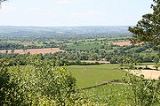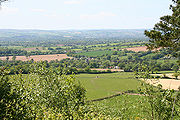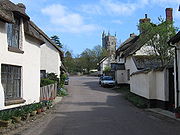
Broadhembury
Encyclopedia
Broadhembury is a village and civil parish
in the East Devon
district of Devon
, England
, about 5 miles north-west of Honiton
.
According to the 2001 census the village had a population of 654. It is within the Blackdown Hills
Area of Outstanding Natural Beauty.

 Broadhembury is set in the centre of a horse shoe of the hills of Hembury Fort and North Hill, which rise to 1000 feet and create a sheltered, beautiful valley.
Broadhembury is set in the centre of a horse shoe of the hills of Hembury Fort and North Hill, which rise to 1000 feet and create a sheltered, beautiful valley.
Hembury Fort, a prehistoric hill fort dating from 3000BCE that was also used by the Romans
. After the departure of the Romans
this area of Devon
was sparsely occupied by the Celtic people. In these years Hembury Fort was called Handria.
With the arrival of the Saxons
little wattle churches were built and the villagers lived in little cells or wooden huts. The Saxons
brought the plough
and cultivated the holdings.
At the time of the Norman conquest of England
in 1066, the population density
of Broadhembury was 9 per square mile.
During the Black Death
of 1364, the population was affected, with 2 priests dying of it.
Henry VIII
presented the land at Broadhembury to his faithful courtier, Thomas Wriothesley
, Earl of Southampton
, who sold it Sir Thomas Drewe, son of Edward Drewe.
Edward Drewe was responsible for the building of the Manor house adjoing a small farm house at Grange in about 1603. Edward was a Sergeant at arms to Queen Elizabeth
.
Broadhembury has changed very little in outward appearance during the last century, with many of the thatch and cob cottages standing since the 16th century.
Julius Drewe
purchased the inn, and half the village
at the turn of the 20th century. Broadhembury House, the large thatched residence on the North side of the church, was converted by him from an old cottage. The Garden, which is of particular beauty, is open on summer weekends to the public.
The descendants of Julius Drewe
of Castle Drogo
, Drewsteignton
, still live in the village in Broadhembury House. It is thanks to Sir Cedric Drewe
, who was a Member of Parliament
for many years that the village has kept its excellent character over the years.
became the vicar in 1768.
Charles Buller Heberden
, Principal of Brasenose College, Oxford
and Vice-Chancellor of Oxford University, was born in the village on 14 May 1849.
Kirstie Allsopp
host of Location, Location, Location has a home in Broadhembury.
Civil parish
In England, a civil parish is a territorial designation and, where they are found, the lowest tier of local government below districts and counties...
in the East Devon
East Devon
East Devon is a local government district in Devon, England. Its council is based in Sidmouth, and the largest town is Exmouth.The district was formed on 1 April 1974 by the merger of the borough of Honiton with the urban districts of Budleigh Salterton, Exmouth, Ottery St. Mary, Seaton, Sidmouth...
district of Devon
Devon
Devon is a large county in southwestern England. The county is sometimes referred to as Devonshire, although the term is rarely used inside the county itself as the county has never been officially "shired", it often indicates a traditional or historical context.The county shares borders with...
, England
England
England is a country that is part of the United Kingdom. It shares land borders with Scotland to the north and Wales to the west; the Irish Sea is to the north west, the Celtic Sea to the south west, with the North Sea to the east and the English Channel to the south separating it from continental...
, about 5 miles north-west of Honiton
Honiton
Honiton is a town and civil parish in East Devon, situated close to the River Otter, north east of Exeter in the county of Devon. The town's name is pronounced in two ways, and , each pronunciation having its adherents...
.
According to the 2001 census the village had a population of 654. It is within the Blackdown Hills
Blackdown Hills
The Blackdown Hills are a range of hills along the Somerset-Devon border in south-western England, which were designated an Area of Outstanding Natural Beauty in 1991....
Area of Outstanding Natural Beauty.
History


Hembury Fort, a prehistoric hill fort dating from 3000BCE that was also used by the Romans
Roman Empire
The Roman Empire was the post-Republican period of the ancient Roman civilization, characterised by an autocratic form of government and large territorial holdings in Europe and around the Mediterranean....
. After the departure of the Romans
Roman Empire
The Roman Empire was the post-Republican period of the ancient Roman civilization, characterised by an autocratic form of government and large territorial holdings in Europe and around the Mediterranean....
this area of Devon
Devon
Devon is a large county in southwestern England. The county is sometimes referred to as Devonshire, although the term is rarely used inside the county itself as the county has never been officially "shired", it often indicates a traditional or historical context.The county shares borders with...
was sparsely occupied by the Celtic people. In these years Hembury Fort was called Handria.
With the arrival of the Saxons
Saxons
The Saxons were a confederation of Germanic tribes originating on the North German plain. The Saxons earliest known area of settlement is Northern Albingia, an area approximately that of modern Holstein...
little wattle churches were built and the villagers lived in little cells or wooden huts. The Saxons
Saxons
The Saxons were a confederation of Germanic tribes originating on the North German plain. The Saxons earliest known area of settlement is Northern Albingia, an area approximately that of modern Holstein...
brought the plough
Plough
The plough or plow is a tool used in farming for initial cultivation of soil in preparation for sowing seed or planting. It has been a basic instrument for most of recorded history, and represents one of the major advances in agriculture...
and cultivated the holdings.
At the time of the Norman conquest of England
Norman conquest of England
The Norman conquest of England began on 28 September 1066 with the invasion of England by William, Duke of Normandy. William became known as William the Conqueror after his victory at the Battle of Hastings on 14 October 1066, defeating King Harold II of England...
in 1066, the population density
Population density
Population density is a measurement of population per unit area or unit volume. It is frequently applied to living organisms, and particularly to humans...
of Broadhembury was 9 per square mile.
During the Black Death
Black Death
The Black Death was one of the most devastating pandemics in human history, peaking in Europe between 1348 and 1350. Of several competing theories, the dominant explanation for the Black Death is the plague theory, which attributes the outbreak to the bacterium Yersinia pestis. Thought to have...
of 1364, the population was affected, with 2 priests dying of it.
Henry VIII
Henry VIII of England
Henry VIII was King of England from 21 April 1509 until his death. He was Lord, and later King, of Ireland, as well as continuing the nominal claim by the English monarchs to the Kingdom of France...
presented the land at Broadhembury to his faithful courtier, Thomas Wriothesley
Thomas Wriothesley, 1st Earl of Southampton
Thomas Wriothesley, 1st Earl of Southampton, KG , known as The Lord Wriothesley between 1544 and 1547, was a politician of the Tudor period born in London to William Wrythe and Agnes Drayton....
, Earl of Southampton
Earl of Southampton
Earl of Southampton was a title that was created three times in the Peerage of England. The first creation came in 1537 in favour of the courtier William Fitzwilliam. He was childless and the title became extinct on his death in 1542. The second creation came in 1547 in favour of the politician...
, who sold it Sir Thomas Drewe, son of Edward Drewe.
Edward Drewe was responsible for the building of the Manor house adjoing a small farm house at Grange in about 1603. Edward was a Sergeant at arms to Queen Elizabeth
Elizabeth I of England
Elizabeth I was queen regnant of England and Ireland from 17 November 1558 until her death. Sometimes called The Virgin Queen, Gloriana, or Good Queen Bess, Elizabeth was the fifth and last monarch of the Tudor dynasty...
.
Broadhembury has changed very little in outward appearance during the last century, with many of the thatch and cob cottages standing since the 16th century.
Julius Drewe
Julius Drewe
Julius Charles Hendicott Drewe was an English businessman, retailer and entrepreneur, known for being the creator of the successful Home and Colonial Stores, as well as for the building of Castle Drogo in Devon as his family's country home.-Early life and career:Julius Charles Hendicott Drew...
purchased the inn, and half the village
Village
A village is a clustered human settlement or community, larger than a hamlet with the population ranging from a few hundred to a few thousand , Though often located in rural areas, the term urban village is also applied to certain urban neighbourhoods, such as the West Village in Manhattan, New...
at the turn of the 20th century. Broadhembury House, the large thatched residence on the North side of the church, was converted by him from an old cottage. The Garden, which is of particular beauty, is open on summer weekends to the public.
The descendants of Julius Drewe
Julius Drewe
Julius Charles Hendicott Drewe was an English businessman, retailer and entrepreneur, known for being the creator of the successful Home and Colonial Stores, as well as for the building of Castle Drogo in Devon as his family's country home.-Early life and career:Julius Charles Hendicott Drew...
of Castle Drogo
Castle Drogo
Castle Drogo is a country house near Drewsteignton, Devon, England. It was built in the 1910s and 1920s for Julius Drewe to designs by architect Edwin Lutyens, and is a Grade I listed building...
, Drewsteignton
Drewsteignton
Drewsteignton is a village and civil parish within the administrative area of West Devon, England, also lying within the Dartmoor National Park. It is located in the Teign valley, west of Exeter and south east of Okehampton...
, still live in the village in Broadhembury House. It is thanks to Sir Cedric Drewe
Cedric Drewe
Sir Cedric Drewe, KCVO was a British Conservative Party politician. He was the son of Julius Drewe, the English businessman, retailer and entrepreneur....
, who was a Member of Parliament
Member of Parliament
A Member of Parliament is a representative of the voters to a :parliament. In many countries with bicameral parliaments, the term applies specifically to members of the lower house, as upper houses often have a different title, such as senate, and thus also have different titles for its members,...
for many years that the village has kept its excellent character over the years.
People
Augustus Montague TopladyAugustus Montague Toplady
Augustus Montague Toplady was an Anglican cleric and hymn writer. He was a major Calvinist opponent of John Wesley. He is best remembered as the author of the hymn "Rock of Ages"...
became the vicar in 1768.
Charles Buller Heberden
Charles Buller Heberden
Charles Buller Heberden was an English classical scholar and academic administrator. He was Principal of Brasenose College, Oxford and served as Vice-Chancellor of Oxford University....
, Principal of Brasenose College, Oxford
Brasenose College, Oxford
Brasenose College, originally Brazen Nose College , is one of the constituent colleges of the University of Oxford in the United Kingdom. As of 2006, it has an estimated financial endowment of £98m...
and Vice-Chancellor of Oxford University, was born in the village on 14 May 1849.
Kirstie Allsopp
Kirstie Allsopp
Kirstie Mary Allsopp is a British TV presenter known for the Channel 4 property programmes: Location, Location, Location; Relocation, Relocation; Location Revisited; The Property Chain; Kirstie's Homemade Home and Kirstie's Handmade Britain...
host of Location, Location, Location has a home in Broadhembury.

